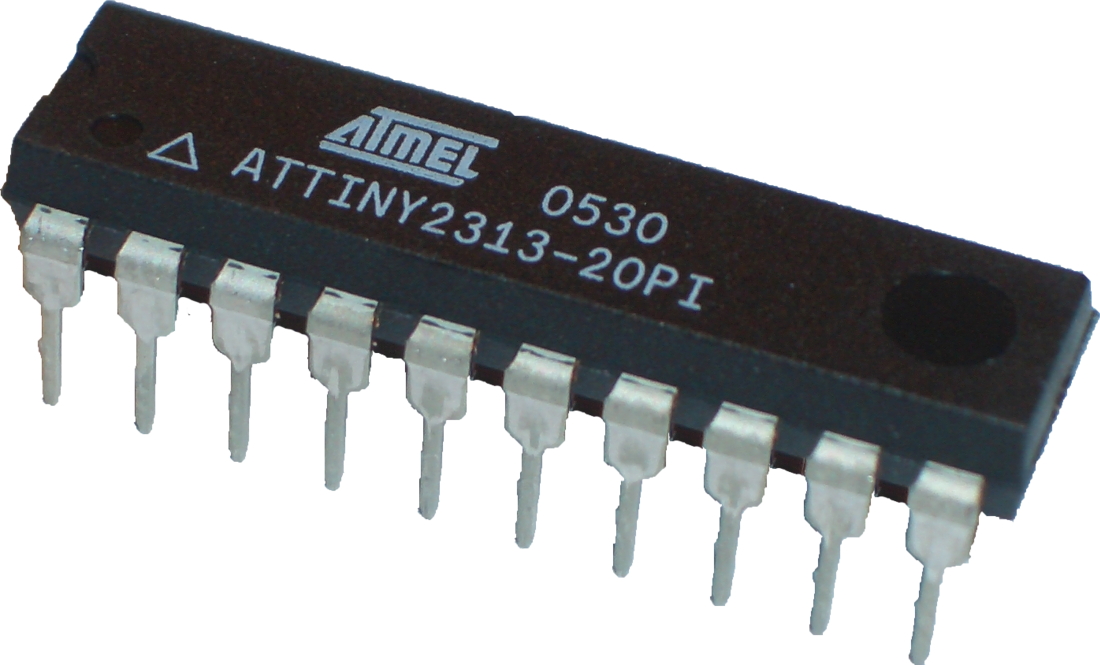Top Qs
Timeline
Chat
Perspective
ATtiny microcontroller comparison chart
Subfamily of 8-bit AVR microcontrollers From Wikipedia, the free encyclopedia
Remove ads
ATtiny (also known as TinyAVR) is a subfamily of the popular 8-bit AVR microcontrollers, which typically has fewer features, fewer I/O pins, and less memory than other AVR series chips. The first members of this family were released in 1999 by Atmel (later acquired by Microchip Technology in 2016).[1]

Features
Summarize
Perspective
ATtiny microcontrollers specifically exclude various common features, such as: USB peripheral, DMA controller, crypto engine, or an external memory bus.
The following table summarizes common features of the ATtiny microcontrollers, for easy comparison. This table is not meant to be an unabridged feature list.
- Notes
- Ultra-low voltage model with integrated boost converter that can be powered with only 0.7 volts.
- Package column - the number after the dash is the number of pins on the package. DIP packages in this table are 0.3 inches (7.62 mm) row-to-row. SOwww means SOIC package with a case width of 'www' in thousandth of an inch. Though some package types are known by more than one name, a common name was chosen to make it easier to compare packages.
- UART/I²C/SPI columns - green cell means a dedicated peripheral, * yellow cell means a multi-feature peripheral that is chosen by setting configuration bits. Most USART peripherals support a minimum choice between UART or SPI, where as some might support additional choices, such as LIN, IrDA, RS-485.
- Timers column - more recent families have wider timers and may allow chaining two 16-bit timers to do 32-bit capture. RTT is a 16-bit Real Time Timer that is driven by a 32.768KHz clock, though Microchip calls it RTC for Real Time Counter (easily confused to mean Real Time Clock).
- ADC pins column - the total number of analog channels that are accessible via pins that multiplex into the ADC input. Most parts have one ADC, a few have two ADC.
- Pgm/Dbg column - flash programming and debugging protocols: HVPP means High Voltage Parallel Programming 12V protocol, HVSP means High Voltage Serial Programming 12V protocol, ISP means In-System Programmable protocol, uses SPI to program the internal flash. TPI is Tiny Programming Interface. dW means debugWIRE protocol. UPDI means Unified Program and Debug Interface protocol (newest).[78]
- Abbreviations
- TWI: Many of Atmels microcontrollers contain built-in support for interfacing to a two-wire bus, called Two-Wire Interface. This is essentially the same thing as the I²C interface by Philips, but that term is avoided in Atmel's documentation due to trademark issues.
- USI: Universal Serial Interface (not to be confused with USB). The USI is a multi-purpose hardware communication module. With appropriate software support, it can be used to implement an SPI,[79] I²C[80][81] or UART[82] interface. USART peripherals have more features than USI peripherals.
Remove ads
Timeline
Summarize
Perspective

The following table lists each ATtiny microcontroller by the first release date of each datasheet.
Remove ads
Development boards
The following are ATtiny development boards sold by Microchip Technology:
See also
References
Further reading
External links
Wikiwand - on
Seamless Wikipedia browsing. On steroids.
Remove ads
